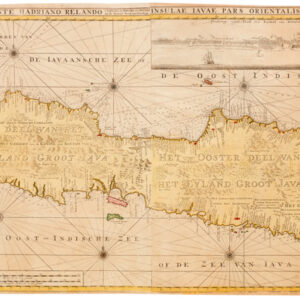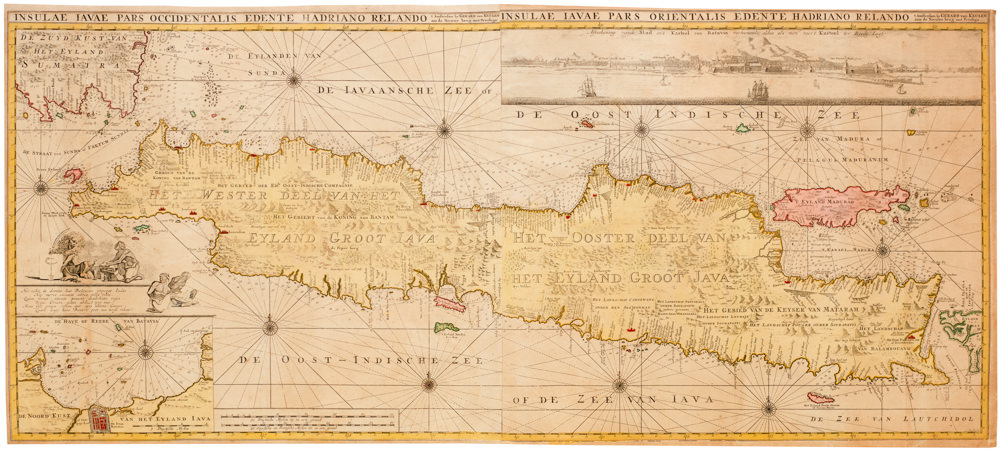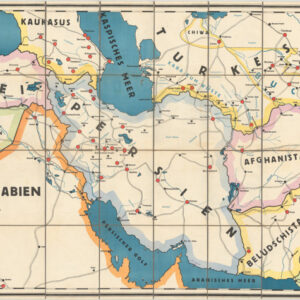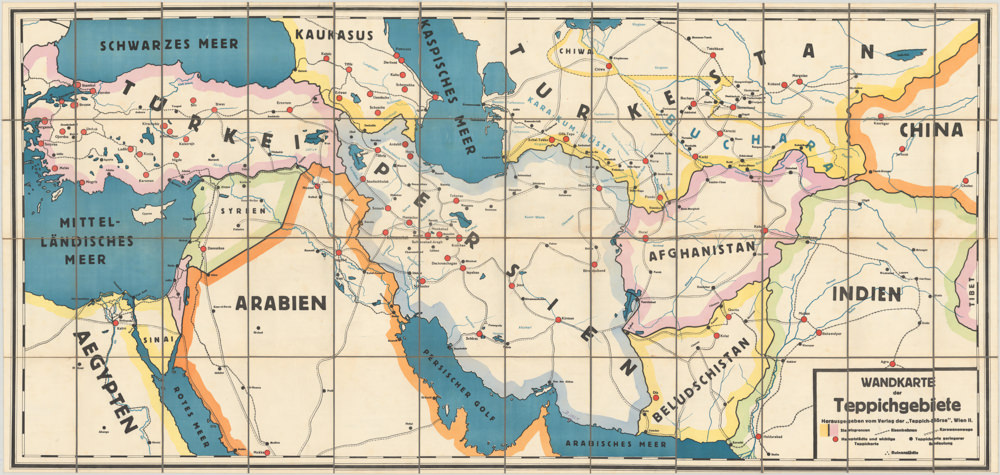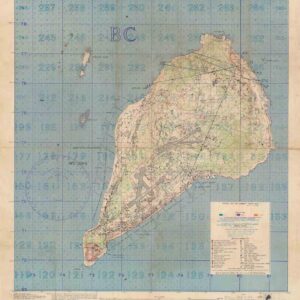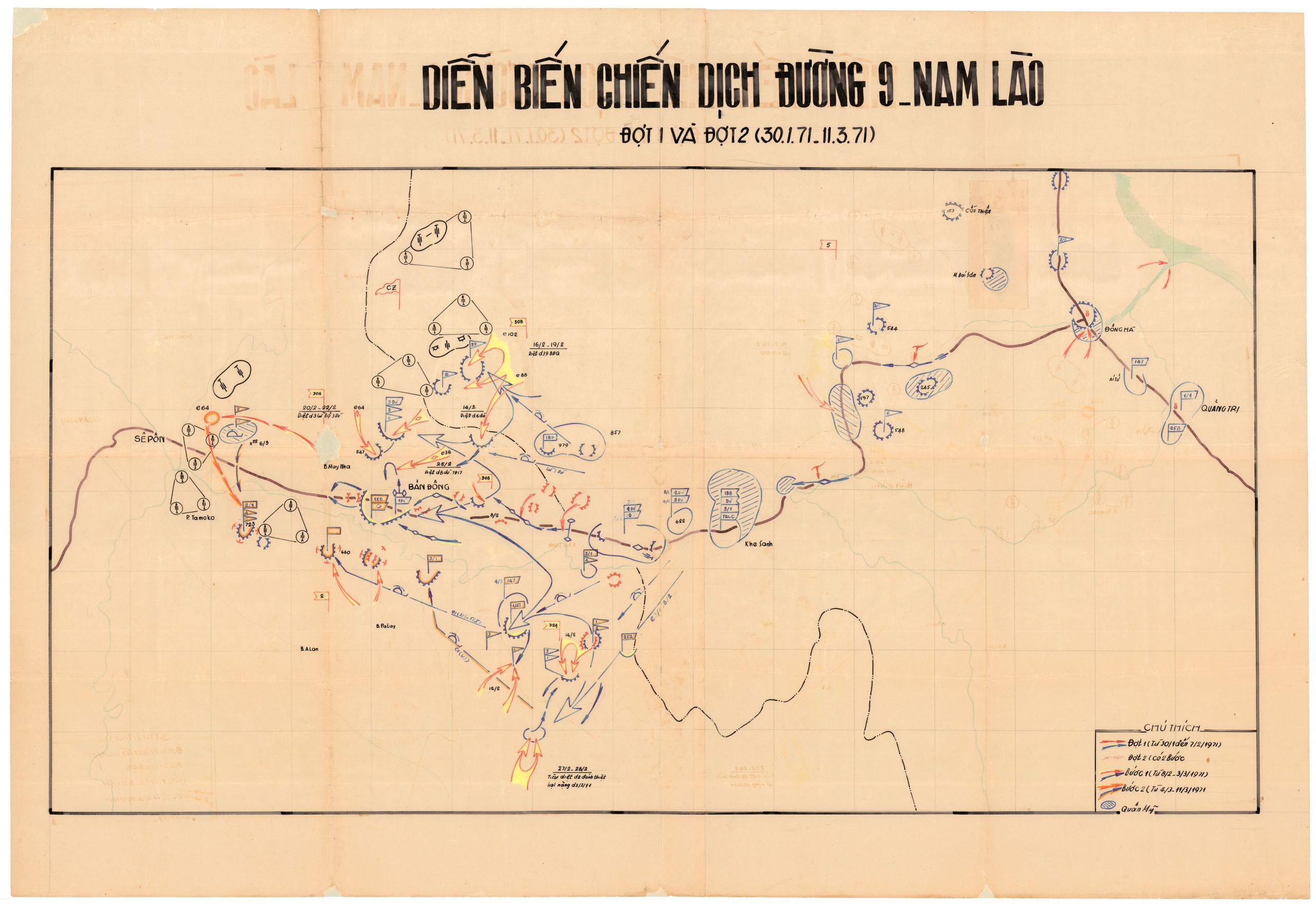Superb first state of Doncker’s chart of the Pacific with California as an island.
Pascaart vertoonende de Zeecusten van Chile, Peru, Hispania Nova, Nova Granada, en California.
Out of stock
Description
Click here to see a video we made about this map.
First state (recognizable because subsequent states include an added delineation of the Gulf of Mexico and the Yucatan Peninsula).
With both the greatest of cartographic myth and important discoveries less than a generation old.
In this important and absorbing map, we see a fascinating mix of the most up-to-date cartographic data and some of the most famous cartographic myths. Publisher Hendrick Doncker employs an innovative structure with the main map at a different orientation than the three insets in order to include as much information as possible, much of it from recent explorations sponsored by the Dutch East India Company.
The main section is a chart of the west coast of the Americas, oriented with east at the top, stretching horizontally across the page from an enigmatic promontory called Agubela de Cato at the 47th parallel north to just south of Arica, Chile.
The most impressive feature of this important work is clearly its representation of the Island of California, done so on a larger scale than any earlier sea chart (Burden). The island follows the so-called Second Sanson Model, traced to a new map of Insular California published by Sanson in 1656 (which in turn was based on a 1635 map of the expedition of Luxe Foxe, despite the fact that Foxe never actually went to California). Sanson’s map contained a number of new features concerning the shape and nomenclature of the island of California, most notably a northern coastline indented with two large bays, as well as a distinctive piece of land jutting out from the opposite mainland. This outcropping promontory, which is separated from the island of California by a body of water filled with a set of newly depicted islands, is labeled Agubela de Cato, the origin of which we have been unable to track down. In his Cartography of the Northwest, Wagner states: “This imaginary name first appears according to present knowledge on Blaeu’s map ‘Nova Totius Terrarum Orbis Tabula,’ usually ascribed to the year 1648. The ‘Cato’ of this map is undoubtedly an error for ‘Gato.’ The origin of it is unknown but the name recalls the ‘Cabo de Gato’ which was located somewhere in the mythical Strait of Bacalaos’ (Wagner p. 458).
In the upper right hand corner of the island of California we see the place name R. de Estrete, which is applied either to the northernmost bay or peninsula (it is unclear). This is an interesting relic of earlier debates regarding the insularity of California, the existence of a Northwest Passage, and indeed the basic general geography of this unknown part of the earth. It refers to the River of the Straight (Rio de Estrete), which was linked to the idea that the entrance of the Colorado River into the Gulf of California was actually an end point of a transcontinental river that traversed North America and linked the Pacific and Atlantic Oceans. The Second Sanson Model geography has rendered this cartographic remnant amusingly without meaning: a River of the Straight with no river!
The island features many other place names, including: the Canael de S. Barbara, P. de Monte Rey, P. Conception, P. de S. Diego, C. Mendocino, B. de S. Quentin, C. Blanco, and C. de Engaño, the Cape of Disappointment, so named because it was at this latitude that early Spanish explorers expected to find the north end of the Island of California. The Galápagos Islands are shown, having been first sighted by Europeans in the previous century.

Doncker has employed decorative vegetal bands to divide the main map and the three insets. For their part, the insets are all oriented with north at the top.
Inset #1
The inset to the right of the title cartouche shows parts of Japan and Hokkaido (Yedso), along with two of the Kuril Islands, Iturup (Staten landt), and Urup (Compagnies landt). Hokkaido is the second largest island of Japan, and appears on early maps as Ezo, Yezo, Yedso, Yesso, and other similar variations. To understand why Hokkaido has been given its own inset, we look back to late 16th century Jesuit activity in the Far East. Father Xavier, an early missionary in China, related stories that silver mines were to be found in Japan. Spanish traders heard similar rumors, which became sufficiently widespread that the great cartographer Abraham Ortelius placed an ‘island of silver’ (Isla de Plata) above Japan on his 1589 Maris Pacifici map of the Pacific Ocean.
The allure of silver endured, and fifty years after the publication of Maris Pacifici the Dutch East India Company sponsored two voyages of exploration in the region, first by Abel Tasman in 1639, then by Maarten Vries in 1643. This inset map reflects the new information recorded by Vries, who sailed through the straight that was later named after him between the islands of Iturup and Urup, and into the Sea of Okhotsk. He later died at sea near Manila from disease after an unsuccessful attempt to invade the Philippines.
In the end, the greatest cartographic legacy of the Vries expedition was an error made concerning the Kurili Island of Urup, which he believed to be continental. The island, which Vries named Comagnies landt after his employer the Dutch East India Company, is thus left as an open coastline on our map. Vries perceived this land to be the westernmost region of America, a concept that was widely adopted in the 17th and 18th centuries, for example by Vincenzo Coronelli in his Mare Del Sud detto altrimenti Mare Pacifico.
Inset #2
Below inset #1 we see the largest of the three insets. It presents the islands of Oceania, which at the time of the map’s publication were being discovered and mapped with each new voyage of exploration. In the lower right corner we see the first two European discoveries in Oceania: I. de los Tiburons and I. de S. Petro. These islands were first sighted by Magellan and his crew during their c. 1519-22 circumnavigation of the world. Among the crew was the Venetian scholar and explorer Antonio Pigafetta, who recounted: “we saw but two uninhabited islands, where we saw no other things than birds, and trees, and for this reason we called them the Unfortunate Isles…we found no anchorage there, and there were many fish called tiberons [sharks] there.” These two islands appear in different locations and at different scales on maps for over two centuries.
The map archipelago mapped in the the inset are the Mariana Islands, which were also observed by Magellan’s expedition. Doncker makes references to two names for the islands: Islas de las Velas alias Ladrones. ‘Velas’ is short for Islas de las Velas Latinas, the ‘islands of the Lateen sails,’ named for the triangle-shaped sails on the canoes used by local mariners. ‘Ladrones,’ on the other hand, is short for Islas de los Ladrones (‘islands of thieves’), so-named by Magellan after a dispute with the native inhabitants.
To the south we see a small section of the coast of the island of New Ireland in today’s Papua New Guinea. It is perhaps included because of a few decades earlier, in 1616, this area was the site of a violent clash between the local population and Dutch mariners.
Other islands include I. de los Nadadrones (‘island of the swimmers’), so-named because the people of the islands made an impressive swim out to meet the ships, and I. d. Paxaro (‘island of the birds’), a small island filled with birds.
Inset #3
The final inset delineates part of the eastern coastline of New Zealand, just 17 years after its European discovery in December of 1642 by Abel Tasman. Tasman described the islands as a “lofty and mountainous country,” and named the islands ‘Staten Land’ in the belief that they were part of the same land sighted by Jacob Le Maire off South America. Tasman, of course was quite mistaken, as these islands were separated from Tierra del Fuego by a vast ocean. By the time our map was published, the islands had been renamed ‘Nova Zeelandia’ after the Dutch province of Zeeland.
The map includes several place names, including ‘Murderers Bay’ (Mourdenaers bay) — modern-day Golden Bay, an appellation given by Tasman because hostile local Maoris killed four of his Dutch crew there.
Cartographer(s):
Hendrick Doncker (1626-1699) was a cartographer and map seller based in Amsterdam.
Condition Description
Original color with later additions, with gold highlights. Repaired chips in margins. A fine example.
References
Suárez, Thomas. Early Mapping of the Pacific. Hong Kong: Periplus, 2004.
McLaughlin with Mayo, The Mapping of California as an Island: An Illustrated Checklist, map 21.
Wagner, H. R. The Cartography of the Northwest coast of America to the year 1800. Amsterdam, 1968.
